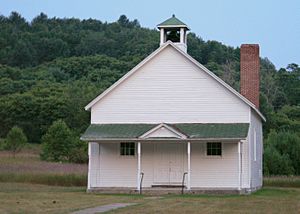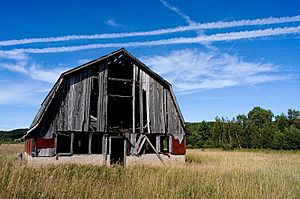Port Oneida Rural Historic District facts for kids
Quick facts for kids |
|
|
Port Oneida Rural Historic District
|
|

Sign for the district
|
|
| Location | Leelanau Peninsula, Michigan |
|---|---|
| Area | Northern Michigan |
| Built | mid-1800s to mid-1900s |
| NRHP reference No. | 97000563 |
| Added to NRHP | June 1, 1997 |
The Port Oneida Rural Historic District is a special place in Northern Michigan. It's part of the Sleeping Bear Dunes National Lakeshore. This district shows what farm life was like over 100 years ago. It has many old farms that look just like they did in the late 1800s and early 1900s.
These farms were settled by people from Northern Europe. They show how farming, building, and farm tools changed over time in the Great Lakes area. It's really rare to find so many old farms together that haven't been changed by modern technology.
The Port Oneida district covers over 3,400 acres. It has 121 buildings, 20 structures, and 18 farmsteads. It is the biggest historic farming area in the United States that the government owns and protects. It was added to the National Register of Historic Places in 1997.
Contents
History of Port Oneida
Early Settlers and the Land
People have lived in the Leelanau Peninsula since the Ice age ended. They first came for the fish and forests. Later, farming became important because the area had good growing seasons. Lake Michigan helped keep the shoreline warm. Native American groups like the Cree and Ojibwa lived here for many years.
The first European to be recorded in this area was Carsten Burfiend. He came from Hanover, Germany in 1846. He first went to North Manitou Island and worked as a fisherman. In 1852, the U.S. government opened the Michigan mainland for settlement. Burfiend bought 275 acres of land and brought his family to live there.
Burfiend kept fishing and also used his boat to ferry early settlers. He helped people travel between the mainland and islands like South Manitou Island. One of his passengers was John E. Fisher, who helped start Glen Arbor. The Burfiend family first lived in a log cabin by the beach. But strong storms from Lake Michigan made them move their home to the bluffs above the lake. Life was hard, and Burfiend sadly lost three of his sons.
Growth of the Community
In 1855, Frederick and Margaretta Werner, who were friends of the Burfiends, also moved from Hanover, Germany. Other settlers from Hanover joined them. By 1860, the Pyramid Point area had 87 people, mostly from Germany and Prussia.
A very important person for Port Oneida was Thomas Kelderhouse. He helped start the logging business there. Kelderhouse was born in Albany, New York in 1821. He owned cargo ships that sailed on Lake Michigan. On one trip, he saw the thick white pine forests on the Michigan mainland.
Kelderhouse and Burfiend agreed to build a dock on Lake Michigan. Burfiend provided the land, and the dock was finished in 1862. The town of Port Oneida was named after the steamship Oneida. This ship was one of the first to stop at Burfiend's new dock.
Logging and Decline
The dock helped the logging industry grow. Kelderhouse bought land and started cutting wood to sell to ships for firewood. He built a sawmill near John Burfiend's farm. Over the next 30 years, Port Oneida became a busy place. It had a general store, a post office, a blacksmith shop, and a boarding house. Kelderhouse owned most of these businesses and a lot of the land. He even built his own home in Port Oneida. He also bought a gristmill in 1866 to process grains.
However, by the 1880s and 1890s, most of the timber was gone. Also, steamships started using coal instead of firewood. Kelderhouse sold his dock and mill by 1880. He died in 1884, and his family's wealth declined.
By 1908, most of the original buildings in Port Oneida were empty. Only the Kelderhouse home was still lived in by his family. It was sold in 1934. Other buildings were torn down later, and their wood was used to build other barns in the area.
Farming in Port Oneida was tough. The sandy soil didn't grow much, and water was limited. Potatoes were the main crop they sold. They also had small herds of dairy cows. Many farmers had to work other jobs to earn enough money. Even so, Port Oneida was a close community. Farmers often helped each other with planting and harvesting crops.
Farm Buildings You Can See
When you visit Port Oneida, you can see many old farm buildings. A typical farmhouse here usually had two stories, with bedrooms upstairs. Some farmhouses still have a Michigan Basement. These basements have thick stone walls and were used to store canned food. Later, furnaces and water heaters were put there. You can also see old outhouses at the Thoreson and Dechow farms.
There are many barns in the district. Most barns had two stories. They were used for cows and calves, especially in winter. You can find corn cribs at the Bufka, Burfiend, Dechow, Eitzen, and Thoreson farms. A granary for storing grain is at the Thoreson, Dechow, and Bufka farms.
Other special buildings include a sugar house at the Oechow farm. A silo for storing animal feed is at the Olsen farm. The Dechow farm has a cement silo, and the Eitzen farm has a tile silo. You can also see milk houses or spring houses at the Dechow and Thoreson farms. Chicken coops are still found at the Dechow, Thoreson, and Lawr farms.
Port Oneida Fair
The Port Oneida Fair happens once a year. It's on the second Friday and Saturday of August. The fair shows what rural life was like in the 1800s and early 1900s. You can see people demonstrating old crafts and farming skills. At the Dechow farm, they show many 19th-century farming techniques. The fair is free to enter, but you need a Park Pass to get into the area.
Images for kids








